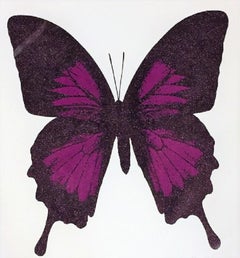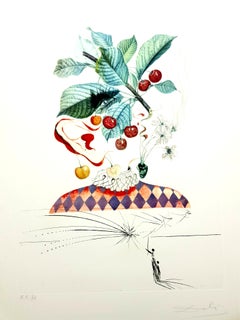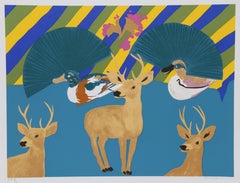Claire Robinson Animal Prints
to
1
Overall Width
to
Overall Height
to
1
1
194
161
118
94
1
1
1
1
1
1
1
1
Artist: Claire Robinson
Papilio Ulysses - Aubergine, Handmade Screen Print, Butterfly Art, Diamond dust
By Claire Robinson
Located in Deddington, GB
A purple butterfly print with diamond dust. A purple butterfly appears in front of a white background.
Additional information:
Claire Robinson: Papilio Ulysses - Aubergine.
Foam on ...
Category
2010s Abstract Claire Robinson Animal Prints
Materials
Screen, Paper
Related Items
Salvador Dali - Cherries - Original Hand-Signed Lithograph
By Salvador Dalí
Located in Collonge Bellerive, Geneve, CH
Salvador Dali - Cherries - Original Hand-Signed Lithograph
Dimensions: P. 57 x 37 cm
Sheet: 75 x 56 cm
Handsigned
Edition: EC.d (collaborator edition "d")
Excellent Condition
Refer...
Category
1960s Surrealist Claire Robinson Animal Prints
Materials
Lithograph
$6,152
H 29.53 in W 22.05 in D 0.4 in
Three Deer, Pop Art Screenprint by Hunt Slonem
By Hunt Slonem
Located in Long Island City, NY
Artist: Hunt Slonem, American (1951 - )
Title: Three Deer
Year: 1980
Medium: Screenprint, signed and numbered in pencil
Edition: AP 30
Image Size: 24 x 32 inches
Size: 26 in. ...
Category
1980s Pop Art Claire Robinson Animal Prints
Materials
Screen
The Celestial Hippocampus (Ed. 88/140)
Located in Dallas, TX
"The Scar by China Miéville is a novel which has been a part of my life for many years, and has travelled as my companion through since adolescence. I've attempted to depict the Avan...
Category
21st Century and Contemporary Surrealist Claire Robinson Animal Prints
Materials
Screen
Echidna and Platypus, Australian animal monotreme antique engraving print
Located in Melbourne, Victoria
'Kloakentiere'
(Monotremes - echidna and platypus))
German wood-engraving, circa 1895.
240mm by 155mm (sheet)
Category
Late 19th Century Naturalistic Claire Robinson Animal Prints
Materials
Engraving
$65
H 9.45 in W 6.11 in
Spotted Leopard and Iris, Photorealist Screenprint by Lowell Nesbitt
By Lowell Nesbitt
Located in Long Island City, NY
Photorealist flower screenprint by American artist Lowell Blair Nesbitt, signed and numbered in pencil.
Title: Spotted Leopard and Iris
Year: 1981
Medium: Serigraph, signed and num...
Category
1980s American Realist Claire Robinson Animal Prints
Materials
Screen
Jean Cocteau - Artaban - Original Lithograph
By Jean Cocteau
Located in Collonge Bellerive, Geneve, CH
Original Lithograph by Jean Cocteau
Title: Artaban
1961
signed in the stone/printed signature
Dimensions: 38 x 28 cm
Lithograph made for the portfolio "Gitans et Corridas" ...
Category
1960s Modern Claire Robinson Animal Prints
Materials
Lithograph
The Roost, Box Set of 5 limited edition prints (ed. 30)
By Thomas Broadbent
Located in New York, NY
This box set of prints includes 5 limited edition prints signed by the artist. (Edition of 30)
This newly released, print set by Thomas Broadbent ...
Category
2010s Contemporary Claire Robinson Animal Prints
Materials
Archival Paper, Archival Pigment
$1,850
H 13 in W 16 in D 0.5 in
Lobster, Pop Art Screenprint by Hunt Slonem
By Hunt Slonem
Located in Long Island City, NY
Artist: Hunt Slonem
Title: Lobster
Year: 1980
Medium: Screenprint, signed and numbered in pencil
Edition: 250; AP 30
Image: 19 x 19 inches
Paper Size: 22 x 30 inches
Category
1980s Contemporary Claire Robinson Animal Prints
Materials
Screen
Cocoa plant, caterpillar, ..., Plate 26, Metamorphosis Insectorum Surinamensium
By Maria Sibylla Merian
Located in Middletown, NY
Metamorphosis Insectorum Surinamensium, Plate No. 26; Cocoa plant, caterpillar, pupa, and butterflies. The Netherlands: 1705. En...
Category
Early 18th Century Naturalistic Claire Robinson Animal Prints
Materials
Watercolor, Engraving
Lily Scent
By Robert Rauschenberg
Located in New York, NY
Robert Rauschenberg
Lily Scent, 1981
Lithograph
32 x 24 inches
SPIII
Signed
Category
1980s Abstract Expressionist Claire Robinson Animal Prints
Materials
Lithograph
After Harnett
Located in Red Bank, NJ
After Harnett by Kimberly Witham
Print, Animal, Still-Life, Bird, Gothic, Dark Colors, Textured
Category
20th Century Gothic Claire Robinson Animal Prints
Materials
Rag Paper, Archival Pigment
"Carrier Pigeon" Signed Limited Edition Black and White Silkscreen Print
Located in East Quogue, NY
“Carrier Pigeon,” 2012, Limited edition silkscreen print by Baltimore street artist Gaia.
Three-color hand-pulled silkscreen on Coventry Rag, 100% Cotton Archival Paper. Edition 25/...
Category
2010s Contemporary Claire Robinson Animal Prints
Materials
Archival Paper, Black and White, Archival Pigment
Previously Available Items
Papilio Ulysses Quadtych
By Claire Robinson
Located in Deddington, GB
Claire Robinson – Papilio Ulysses – Aubergine £306.25
Claire Robinson – Papilio Ulysses – Deep Gold £306.25
Claire Robinson – Papilio Ulysses – Neon Pink £306.25
Claire Robinson – Pa...
Category
21st Century and Contemporary Claire Robinson Animal Prints
Materials
Paper, Screen
Claire Robinson animal prints for sale on 1stDibs.
Find a wide variety of authentic Claire Robinson animal prints available for sale on 1stDibs. You can also browse by medium to find art by Claire Robinson in paper, screen print and more. Much of the original work by this artist or collective was created during the 21st century and contemporary and is mostly associated with the abstract style. Not every interior allows for large Claire Robinson animal prints, so small editions measuring 24 inches across are available. Customers who are interested in this artist might also find the work of Francisco Nicolás, Fumiko Toda, and Donald Sultan. Claire Robinson animal prints prices can differ depending upon medium, time period and other attributes. On 1stDibs, the price for these items starts at $324 and tops out at $324, while the average work can sell for $324.



